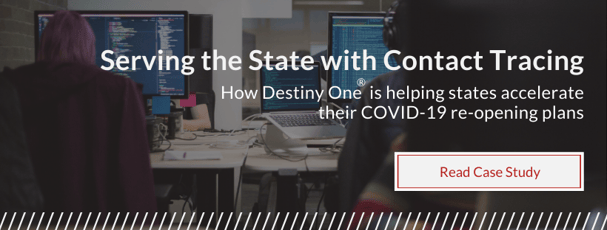Published on
Delivering on a Public University’s Mission with Contact Tracing Training

To accelerate the re-opening of state economies, it’s essential to reduce the spread of coronavirus. The first step to doing so is to hire trained contact tracers in every community, who help to identify and quarantine individuals who have themselves or have been in contact with individuals who contracted the illness.
Training such a workforce is no small matter, and universities are playing a central role in these efforts. Continuing education units in particular are providing support, as they have experience offering customized training in partnership with traditional faculties. But contact tracing requires a speed and scale that most training engagements don’t reach.
In this interview, Eric Bullard explains how UCLA Extension is leveraging its divisional expertise and technological infrastructure to deliver contact tracing training to public employees across the state of California and reflects on how this work is helping to raise the profile of the Extension division across the UC System.
The EvoLLLution (Evo): What is contact tracing training?
Eric Bullard (EB): Contact tracing is used by public health departments to prevent the spread of infectious disease. It’s the process of identifying people who have a particular infectious disease, in this case COVID-19, and then making sure that you trace their contact with other individuals. The whole idea is to identify the cases, isolate the infected individuals and notify other individuals who may have come in contact with that person.
Evo: When talking about contact tracing, how does this work fit in with the public service mission of the university?
EB: It absolutely fits our public service mission. As a public research institution, UCLA is committed to enhancing the lives of California’s citizens. In this particular instance, it’s a real concrete example of how we’re coming together with the Fielding School of Public Health at UCLA to really fulfill that need.
Without our intervention, we essentially wouldn’t have enough people trained in the State of California to reopen it. We couldn’t think of a better example of how we’re fulfilling our public mission than in delivering this program.
Evo: What are some of the unique challenges with managing a program that’s designed and structured in this way?
EB: This has been an interesting project for us because it brings together two distinct faculty groups: the UCLA Fielding School of Public Health faculty and the UC San Francisco faculty. UCSF had started with their pilot project in the San Francisco Bay area, and then received a grant of $8.7 million to develop contact tracing throughout the State of California. They quickly realized that they needed a partner in Southern California, so they reached out to UCLA Extension to support their efforts.
UCSF is the only UC campus that doesn’t have its own university Extension program, so they don’t have the systems in place to manage an offering like this. They didn’t have a registration system like Destiny One or their own learning management system, so they were struggling to build a scalable program.
That’s the service that UCLA Extension has provided. We’re helping them with adult learning pedagogy. We helped them set up a registration structure to serve 20,000 trainees over this project’s lifetime, and then provided the learning management system.
With this program, we’re bringing together numerous different organizational cultures and systems between the Los Angeles and the San Francisco campuses. But on top of that, we’re adding the State of California into the mix. The governor’s office is involved, as are the California Department of Public Health and numerous local health agencies spread out over California. I believe there are 120 local health jurisdictions that we’re also working.
There’s also an inherent challenge in the lack of new hires—they’re redirecting existing state, county and city employees who have either been furloughed or unable to work. That creates a unique dynamic because the people we’re training are coming from places like the California Department of Motor Vehicles. Our first group of trainees included librarians.
These aren’t public health workers. What’s more, many of these folks haven’t been back to a university or continued their education for years, even decades. So, the first challenge is helping these individuals understand why they’re doing this. Second, we need to make it as easy as possible for them to register and start the program.
It’s a very complex project, but it’s really exciting because we’re serving as the hub and bringing everyone together. It’s been challenging but also very rewarding.
Evo: How are you managing the needs and expectations of the stakeholders spread across the state?
EB: It has not been easy. The reality is that the faculty at both institutions have been outstanding to work with. They understand that this is a public health crisis and that we have to come together to address these needs.
The logistical piece behind it is really a nightmare because all the local health jurisdictions have different ways of working.
What’s interesting is that, even in bringing the faculty groups together, we haven’t experienced the typical challenges that we would if we were trying to launch something like this under any other circumstances. We made some modifications to the curriculum, but people are trying to be really generous in working together, and we’re creating clear mechanisms for decision-making.
We have different working groups and different leads. Every week, we bring together the decision-makers, myself included, and key faculty members from UCSF and UCLA. We then decide how we’re going to move forward. But there are also numerous subgroups working on things like registration, learning management systems and all the other pieces that come into play.
Evo: There’s an external belief that higher ed can’t respond quickly to crisis, how have you seen higher ed in general respond to the pandemic?
EB: For traditional brick-and-mortar institutions–and I would very much include UCLA in that category–the pivot overnight to remote instruction and work is really unprecedented.
Thankfully for me, there was an investment in technologies made prior to my arrival that eased the situation. Other Extension units—both in California and across the nation—really struggled because they didn’t have the technology in place that would enable their staff to work remotely, for example.
Here at UCLA, we had most of the systems already in place. Now it’s about refinement: refining the learning process, the educational development process and the quality assurance process. Students demand and expect more—as they should—and we need to meet those expectations. It’s been great watching the entire field change course. It’s kind of fascinating!
Evo: Why are divisions like UCLA Extension so well positioned to support the management of contact tracing?
EB: The fact of the matter is that this is the work we do every day. It isn’t new for us to partner with outside entities to deliver programs or create custom content. And we have the systems in place to make it work. We have Destiny One as an enterprise system for registration and student records management. We have a learning management system, Canvas, to deliver content. We were already using these tools, so it was an easier transition for us.
Our own staff also brings unique expertise. We have advisors and registration staff who are accustomed to working with non-traditional and adult learners. Our faculty, who work on developing these programs, understand best practices around pedagogy and the delivery of educational programs to non-traditional students.
For us, the contact tracing training program is a great example of what every Extension unit can do across the nation. It’s just that they’re generally not given the opportunity to work in the spotlight or to really demonstrate what we can do to effect change across, in this case, an entire state.
Evo: How will your experience in helping to get this program off the ground so quickly and effectively help change the perception that your colleagues, not just at UCLA but across the UC System, may have for the work that Extension is capable of doing?
EB: It’s an opportunity for Extension and Continuing Education leaders to really engage with their campus community and to make sure that faculty understand our abilities. Using UCLA as the example, we’ve worked very well with the faculty at the main campus for decades.
This particular program has really highlighted to UCLA’s leadership and faculty that working with Extension enables everyone further their professional missions.
If we can get away from conversations about finances and the privatization of public universities, for example, and really focus on the fact that we are part of the institution and that we’re critical to ensuring the school can deliver the mission, I think it becomes a whole different conversation.
Colleges and faculties across campus can leverage Extension as a tool and an additional resource—we’re not an organization working in opposition to the main campus.
Evo: What role has Destiny One played in helping you to facilitate that role shift?
EB: In this case specifically, Destiny One was helpful because we were able to use some of the Corporate Engagement modules to further align ourselves with the state’s needs. The training program is restricted to state, city and county workers who are being redirected, so it’s not an open enrollment program. Because of Destiny One’s capabilities, we were able to set up a corporate education portal for individuals to access and register, and it was simple enough that we could get the site up-and-running overnight.
We were able to brand it very specifically as the Virtual Training Academy, which was a requirement of the State of California. We could also easily add both UCSF and UCLA logos into the registration program.
From UCSF’s perspective, they were amazed because they had never seen the Destiny One system. But for us, it’s just how we do business.
Without the system, I’m not sure we could have easily pivoted to meet the need.
Evo: Reflecting back on your experience outside UCLA, what would it have taken to do something like this without Destiny One?
EB: Prior to partnering with us, UCSF and the California Department of Public Health were using Excel spreadsheets and a homegrown system to manage contact tracing. There was no way they were going to be able to scale up and reach their goal of training 20,000 contact tracers. It would have been impossible.
Without an enterprise system like Destiny One, for a program like this, you’d be left manually tracking registrations and the process. You’d have to have countless numbers of staff working on the project.
Destiny One really helps us streamline our operations, so we only have to have two key people working on the project from a registration and records perspective. We have our registrar, and we have one ITS technical team member working on the project. Without Destiny One, I can’t imagine that we could have successfully carried out this project.
Evo: What are some of the fundamental differences between this engagement and a normal contract training engagement?
EB: The major difference is that we’re not working directly with the employer on the program. In this case, the employer is the State of California and specifically Governor Gavin Newsom. We’re not directly working with him, but we’re working with his agency, the California Department of Public Health.
Second, we’re not working to support skills development for employees in a particular job; we’re providing training to help redirect portions of the workforce. And unfortunately, not everyone necessarily wants to do this work, even though they understand the need for it.
There has been some reluctance from the workers coming to us. That’s one core difference because when we work with corporate clients, there’s usually a level of excitement about the engagement. While there’s excitement at the macro-level, on the individual level, there’s a little bit of reluctance, which surprised us because we’re not used to seeing it.
Additionally, in working with the state instead a true corporate client, you don’t necessarily get direct feedback about the training product itself. The governor isn’t able to tell us whether the training we’re offering is helping train the right workforce at the right time because he’s not an expert in public health. The entire project is just so different from a typical arrangement in which you have a manager leading and also giving feedback about whether or not the intended outcomes are being met.
Evo: Is there anything you’d like to add about this experience of launching this training initiative so quickly and some of your learnings or takeaways about what it takes to manage it?
EB: First and foremost, we were really excited to be considered as the Southern California partner for this project. For UCLA Extension, it was an opportunity to work statewide. For me, I felt that if we didn’t engage—given our faculty’s expertise in the medical and public health schools—it would be a missed opportunity for everyone involved.
The ability to showcase what we do every day at UCLA is really rewarding. We normally serve about 36,000 students a year through UCLA Extension. But now, on top of that, we’re adding 20,000 students for contact tracing training.
We’re adding a huge number to the population that we already serve. It’s exciting all around. And to be able to help the state at a time when they really need it is immensely gratifying. Without this program, there would be no way that we could reopen the State of California.
This interview has been edited for length and clarity.
Author Perspective: Administrator




